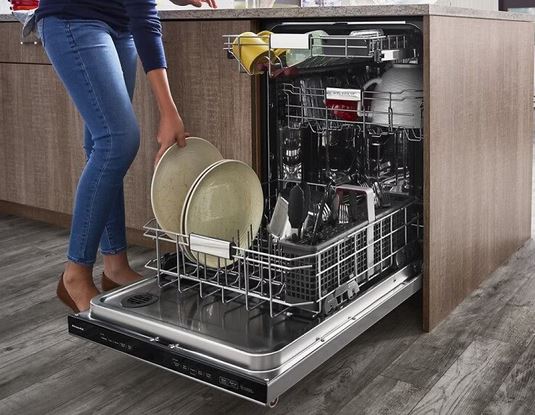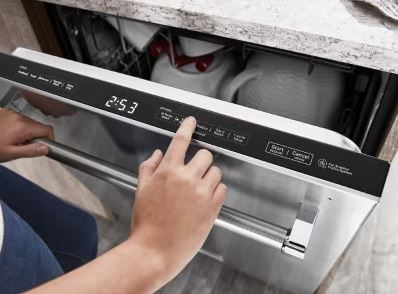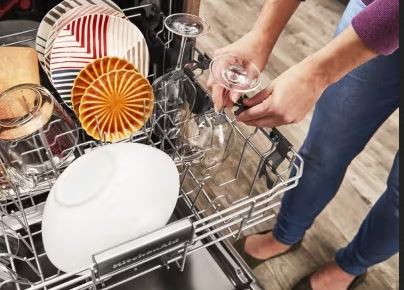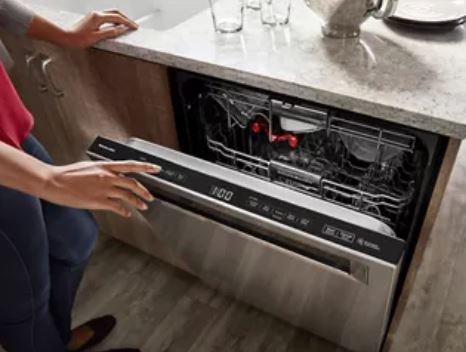We expect our dishwasher to clean the dishes properly once we load it and hit the start button. But what if your Kitchenaid dishwasher won’t clean? How do you explain a Kitchenaid dishwasher troubleshooting not cleaning?
Your Kitchenaid dishwasher isn’t cleaning because of a dish overload, wrong cycle, low Rinse-Aid, water supply fault, hard water use, improper rack positioning, dirty tub, component obstruction, or poor lathering.
It generally takes one of those nine issues to stop your Kitchenaid dishwasher from doing its job – that of cleaning the dishes. But likewise, it takes only one fix to troubleshoot it, and I’ll walk you through it.
This Kitchenaid dishwasher troubleshooting guide will enable you to identify why your dishwasher won’t wash the dishes and how to get it back cleaning quickly. Without further ado, let’s dive into the nine issues!
In a rush? Below are quick fixes to the various issues that could potentially stop your Kitchenaid dishwasher from washing the dishes.

Kitchenaid Dishwasher Troubleshooting Not Cleaning – Quick Guide
| – | Likely Cause | What to Check | Quick Fix |
| 1. | Dish Overload | Overfilled dishwasher or blocked spray arms (by dishes) | Don’t overload or overlap the dishes. Avoid obstructing the spray arms. |
| 2. | Wrong Cycle | Rinse-Only, Top Rack-Only, or Normal Cycle for heavy load | Choose a Full Wash over Rinse-Only, cancel Top Rack-Only if not deliberate, and use a Heavy Cycle on a heavy load. |
| 3. | Low Rinse-Aid | Low Rinse-Aid Indicator light or Empty Rinse-Aid dispenser | Refill Rinse-Aid |
| 4. | Water Supply Fault | An OFF water supply line, kinked inlet hose, low water pressure (under 20 psi), low water temperature (below 1200F), or blocked spray arm nozzles | Turn on the water supply line, unkink the inlet hose, raise the water pressure to at least 20 psi and the water temperature to at least 1200F, and unblock the spray nozzles. |
| 5. | Hard Water Use | Water line, spots, and streaks | Use enough detergent, Rinse Aid, longer drying cycle, and dishwasher water softener. |
| 6. | Wrong Rack Positioning | Lowered Upper Rack (obstructing the detergent dispenser) | Raise the upper rack |
| 7. | Dirty Tub | Excessive clogging | Clean the dishwasher tub with white vinegar |
| 8. | Component Obstruction | Obstructed filter, spray arms, drain hose, or circulation pump | Unblock the filter, spray arms, drain hose, and circulation pump |
| 9. | Poor Lathering (Excess suds or the lack of it) | Wrong detergent type or amount or a clogged or damaged detergent dispenser | Use the suitable detergent and amount, clean a clogged detergent dispenser, and replace a damaged one |
Why Is My Kitchenaid Dishwasher Not Getting My Dishes Clean?
A Kitchenaid dishwasher is likely to fail to clean your dishes due to one of these nine reasons:
1. Dish Overload
You shouldn’t overfill the dishwasher. If you do, the dishes will obstruct the spray arms, stopping water and detergent from reaching the dishes. That could be why your dishes are coming out of the dishwasher dirty.
Fix
Avoid overloading the dishwasher. Ensure no dishes are overlapping and none is blocking the spray arms.
2. Wrong Cycle
Your Kitchenaid dishwasher won’t clean the dishes if the setting is incorrect. For example, you cannot expect the dishwasher to fully clean the dishes if you only select the Rinse-Only setting. Such a setting only allows the dishwasher to rinse the dishes but doesn’t thoroughly clean them.
Likewise, the dishwasher won’t clean the dishes on the lower rack if you only pick Top Rack-Only. Moreover, heavy loads require a Heavy Duty cycle. You can’t use a Normal Cycle in such a case, as the dishes may come out unclean if you do.
Fix
Choose a Full Wash Cycle instead of a Rinse-only and cancel the Top Rack-Only setting if it’s active unless you only want to clean the dishes on the top rack. Additionally, pick a Heavy Duty Cycle for heavy loads.

3. Low Rinse-Aid
The Rinse-Aid is a vital provision that helps remove water marks and streaks, especially when using hard water. What is more, it allows the dishwasher to dry the dishes better.
So, use it. If you don’t, the chances are that the dishes will come out streaked. And even if the dishwasher manages to clean them, they might not dry properly.
Fix
Usually, the Rinse-Aid indicator light comes on when the Rinse-Aid level drops. But even if it doesn’t, you can check the Rinse-Aid dispenser to see if it’s empty. If it is, or perhaps the level is insufficient, refill it.
4. Water Supply Fault
You don’t expect your Kitchenaid dishwasher to wash the dishes if it doesn’t receive water. That could be if the water supply line is off or the inlet hose is kinked.
The dishwasher will also not receive water if the supplying pressure is below 20 psi, which isn’t enough to open the water inlet valve. And if the inlet valve won’t open, the dishwasher won’t get water.
Moreover, the dishwasher might not wash the dishes if the water temperature is below 1200F. Such a temperature isn’t hot enough to clean the dishes. Also, check for clogged spray arm nozzles as they stop spraying water over the dirty dishes.
Fix
First, ensure the water supply line is turned on and straighten any kinks on the inlet hose. Ask an expert to help raise the water pressure if it’s lower than 20 psi and adjust the water heat setting to at least 1200F. And lastly, use a thin wire to unblock the spray nozzles.
5. Hard Water Use
Hard water isn’t the best for washing dishes. For one, it forces you to use excess detergent, which may form water lines, streaks, and spots on the plates. Also, the hard minerals (calcium and magnesium) may stain the dishes.
Fix
Add some detergent, but don’t overuse it, and ensure you’ve enough Rinse-Aid to help reduce the streaks and water lines. Also, consider using a longer drying cycle to get rid of the watermarks, and if all that doesn’t work, use an effective dishwasher water softener (View on Amazon).
6. Wrong Rack Positioning
The lower rack shouldn’t obstruct the detergent dispenser as that’ll stop the dispenser from dispensing the detergent, and as you know, the dishwasher can’t clean the dishes without adequate detergent.
This issue often happens when the upper rack is lowered beyond its normal position. So, check it.
Fix
Raise the upper rack enough not to obstruct the detergent dispenser.

7. Dirty Tub
Sometimes, the dishes won’t come out of the dishwasher because they aren’t clean. That’s why it’s advisable to deep-clean its interior at least once a month. If you don’t, it’s likely to clog up with dirt, food residues, soap scum, and other filth, which may end up staining the dishes after you run a complete cycle.
Fix
Deep-clean your dishwasher, preferably with white vinegar, and here’s how to go about it:
- Pour 3 cups white vinegar into the tub
- Select a hot water setting
- Run the longest cycle
- Leave it to dry
8. Component Obstruction
Your Kitchenaid dishwasher might also fail to wash the dishes because a critical component is obstructed, and it could be any of the following:
- Dishwasher filter – The filter is likely to be blocked up by the food and debris that it traps, and once that happens, it fails to do its job, resulting in dirty dishes.
- Spray arms – The spray arms could be obstructed by the dishes or dirt clog (in the case of the spray holes), as I explained earlier. In either case, the dishwasher may not clean the dishes.
- Drain hose – A kinked drain hose won’t allow the dishwasher to drain correctly, and if it doesn’t drain, some of the dirty water may flow back and contaminate the dishes.
- Circulation pump – If the circulation pump is dirt-obstructed, it won’t force water through the dishwasher’s spray arms, and that stops the dishwasher from cleaning the dishes.
Fix
Clean the dishwasher filter with a soft brush and warm water. Soak it in warm water for a few hours if it’s dirt-caked, but don’t scrub it with a wire brush, as that could damage it.
Use a thin wire to unclog the spray arm holes (nozzles), and ensure you load the dishes correctly to avoid obstructing the spray arms. Straighten any kinks on the drain hose and clean a clogged circulation pump.
9. Poor Lathering
Lastly, consider that your dishwasher might not be cleaning the dishes because it’s over-lathering or under-lathering. Remember, we are talking about overusing the detergent or not using it at all – excess suds or the lack of it.
That could happen when you use the wrong detergent type, especially a lower-quality option, or use the right one but put too much of it or not enough.
But still, it could be an issue of the detergent dispenser being clogged by detergent or damaged and thus won’t dispense the detergent correctly.
Fix
Ensure you use the correct detergent – one that Kitchenaid recommends. And use the right amount. Clean the detergent dispenser if it’s clogged, and replace the detergent. If the dispenser is damaged, replace it.

Kitchenaid Dishwasher Troubleshooting Clean Light Flashing
The Clean Flashing Light is usually an error code, more like the dishwasher beeping, and it typically occurs when the Kitchenaid dishwasher experiences a water temperature fault. You can, however, stop it by resetting the dishwasher. Just plug it out for 1 minute.
Kitchenaid Dishwasher Not Cleaning Top Rack – Troubleshooting
If your Kitchenaid dishwasher to rack won’t clean, consider these issues:
- Spray arm obstruction from overloading the dishes
- Failed water supply from clogged spray arm nozzles, low water pressure, or kinked inlet hose
- Wrong rack positioning
- Poor drainage
- The use of hard water – which streaks and stains the dishes on the top rack
- Excess suds from using too much detergent or just the wrong type
- Faulty circulation pump
Brand New Kitchenaid Dishwasher Not Cleaning
You don’t have to check many things when a brand-new Kitchenaid dishwasher won’t clean dishes. You, however, have to consider the possibility of the dishwasher not getting water, the dishes obstructing the spray arms, the use of hard water, or the selection of an incorrect setting.
Kitchenaid Dishwasher Not Spraying
If your Kitchenaid dishwasher won’t spray water, it’s most likely due to one of these reasons:
- Failure to turn on the water supply
- Kinked water supply hose
- Obstructed spray arm nozzles
- Faulty circulation pump
- Faulty or clogged water inlet valve
- Low water pressure (below 20 psi)
Concluding Thoughts
Now you know the reasons for a Kitchenaid dishwasher troubleshooting not cleaning. You must check those nine issues if you ever want to get your Kitchenaid dishwasher back cleaning efficiently.
Remember, we are discussing the possibility of an overloaded dishwasher, inadequate Rinse Aid, failed water supply, hard water usage, incorrect rack height, filthy tub, obstructed components, or poor Sudsing.
